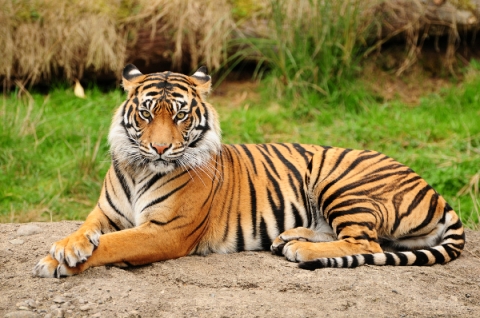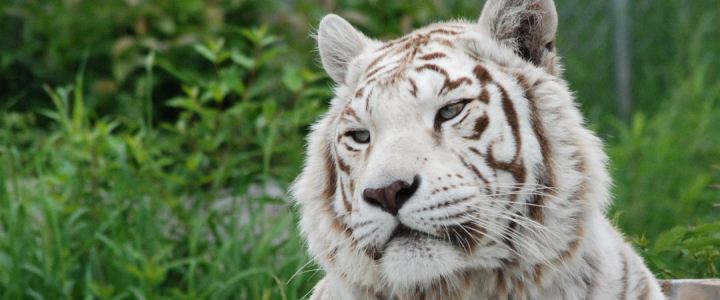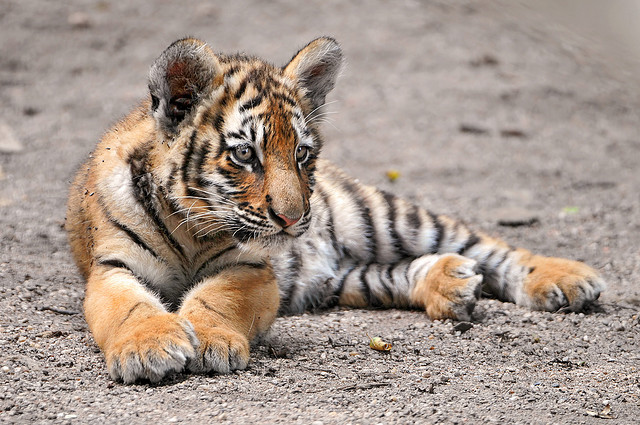| Kingdom: | Animalia |
| Phylum: | Chordata |
| Class: | Mammalia |
| Order: | Carnivora |
| Family: | Felidae |
| Genus: | Panthera |
| Scientific Name: | Panthera Tigris |
| Conservation Status: | Endangered |

The tiger is the largest cat species, most recognisable for their pattern of dark
vertical stripes on reddish-orange fur with a lighter underside.
The tiger is the most powerful of all the big cats, and is native to east and
southern Asia. The tiger is feared by most human beings who inhabit settlements
within the tiger's territory.
Tigers are solitary animals, and hunt by night. To reach their prey, these big cats
can also swim across rivers. They kill their prey by biting the neck, before
dragging it to the place where they want to eat it.
Tigers are among the most recognisable and popular of the world's charismatic mega fauna. They have featured prominently in ancient mythology and folklore, and continue to be depicted in modern films and literature. They appear on many flags, coats of arms, and as mascots for sporting teams. The tiger is the national animal of Bangladesh, India, Malaysia and South Korea


There are six different subspecies of tiger which are the Bengal tiger, tiger, the Indochinese tiger, tiger, the Malayan tiger, tiger, the Sumatran tiger, tiger, the Siberian tiger and the South China Tiger. The white tiger is actually a Bengal tiger.
Description
Tigers have muscular bodies with powerful forelimbs, large heads and long tails. The
fur is dense and heavy; colouration varies between shades of orange and brown with
white ventral areas and distinctive vertical black stripes, whose patterns are
unique to each individual.
Tigers are generally orange with black stripes although it's common to see tigers
with white and sandy coloured markings. The white tiger tiger is a rare type of
tiger, with bright white fur and black stripes, these tigers occur from a genetic
mutation when in the mother tiger's womb.
Size and Habitat
The average tiger weighs around 300kg and a tiger can stretch its body to roughly 4
metres. The Bengal and Siberian subspecies are the tallest at the shoulder and thus
considered the largest living felids, ranking with the extinct Caspian tiger among
the biggest that ever existed. Males vary in total length from 250 to 390 cm (98 to
154 in). Females vary in total length from 200 to 275 cm (79 to 108 in).
They are a notably sexually dimorphic species, females being consistently smaller
than males. The size difference between males and females is proportionally greater
in the larger tiger subspecies, with males weighing up to 1.7 times more than
females. Males also have wider forepaw pads than females, enabling gender to be told
from tracks.
In the past, tigers were found throughout Asia, from the Caucasus and the Caspian
Sea to Siberia and the Indonesian islands of Java, Bali and Sumatra. Today, their
fragmented and partly degraded range extends from India in the west to China and
Southeast Asia. The northern limit of their range is close to the Amur River in
south eastern Siberia. The only large island they still inhabit is Sumatra. Since
the beginning of the 20th century, tigers' historical range has shrunk by 93%. In
the decade from 1997 to 2007, the estimated area known to be occupied by tigers has
declined by 41%.
Tigers can occupy a wide range of habitat types, but will usually require sufficient
cover, proximity to water, and an abundance of prey. A further habitat requirement
is the placement of suitably secluded den locations, which may consist of caves,
large hollow trees, or dense vegetation.
Tiger Cubs
Tigers usually mate from November to April and after a gestation period of just over 3 months the female tiger gives birth to 2 or 3 tiger cubs. When the tiger cubs are first born they are blind and extremely vulnerable. By the time the tiger cub is around 18 months old, it is able to hunt for itself. Tiger cubs are known to grow rapidly and can put on 100 g of weight every day. The tiger cubs usually stay with their mother until they are between 2 and 3 years old and the tiger cubs are then big enough and strong enough to venture out into the jungle to live a life of solitude.
Edangered!
Today the tiger is a near endangered species with only a handful still roaming the
Asian jungles.
Reasons behind this are:
- The tiger has been one of the big five game animals of Asia. Tiger hunting took place on a large scale in the early 19th and 20th centuries, being a recognised and admired sport by the British in colonial India as well as the Maharajas.
- Historically, tigers have been hunted at a large scale so their famous striped skins could be collected.
- The trading of tiger parts in Asia has become a major black market industry and governmental and conservation attempts to stop it have been ineffective to date.


